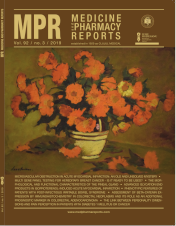Comparing patient safety culture in Bulgarian, Croatian and American hospitals – preliminary results
DOI:
https://doi.org/10.15386/mpr-1267Keywords:
patient safety culture, healthcare, HSOPSCAbstract
Background and aims. Patient safety culture (PSC) is an essential component of the quality of healthcare. Improving PSC is considered a priority in many developed countries. A specialized software platform for registration and evaluation of hospital patient safety culture has been developed with the support of the Medical University Plovdiv Project №11/2017.
The aim of the study is to assess the status of PSC in Bulgarian hospitals and to compare it to that in USA and Croatian hospitals.
Methods. The study was conducted from June 01 to July 31, 2018 using the web-based Bulgarian Version of the Hospital Survey on Patient Safety Culture Questionnaire (B-HSOPSC). Two hundred and forty-eight medical professionals from different hospitals in Bulgaria participated in the study. In order to quantify the differences of positive scores distributions for each of the 42 HSOPSC items between Bulgarian, Croatian and USA samples, the χ2-test was applied. The research hypothesis assumed that there were no significant differences between the Bulgarian, Croatian and US PSCs.
Results. The results revealed 14 significant differences in the positive scores between the Bulgarian and Croatian PSCs and 15 between the Bulgarian and the USA PSC, respectively. Bulgarian medical professionals provided less positive responses to 12 items compared with Croatian and USA respondents. The Bulgarian respondents were more positive compared to Croatians on the feedback and communication of medical errors (Items - C1, C4, C5) as well as on the employment of locum staff (A7) and the frequency of reported mistakes (D1). Bulgarian medical professionals were more positive compared with their USA colleagues on the communication of information at shift handover and across hospital units (F5, F7). The distribution of positive scores on items: “Staff worry that their mistakes are kept in their personnel file” (RA16), “Things ‘fall between the cracks’ when transferring patients from one unit to another” (RF3) and “Shift handovers are problematic for patients in this hospital” (RF11) were significantly higher among Bulgarian respondents compared with Croatian and US respondents.
Conclusions. Significant differences of positive scores distribution were found between Bulgarian and USA PSC on one hand and between Bulgarian and Croatian on the other. The study reveals that distribution of positive responses could be explained by the cultural, organizational and healthcare system differences.
Downloads
Published
How to Cite
Issue
Section
License
The authors are required to transfer the copyright of the published paper to the journal. This is done by agreeing to sign the Copyright Assignment Form. Whenever the case, authors are also required to send permissions to reproduce material (such as illustrations) from the copyright holder.

The papers published in the journal are licensed under a Creative Commons Attribution-NonCommercial-NoDerivatives 4.0 International License.

